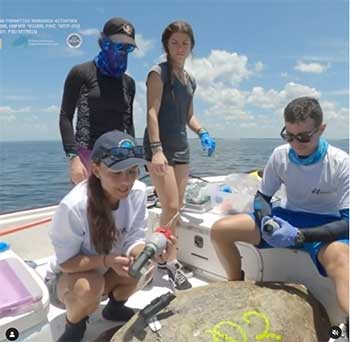Grant: 21-028R
Project Title: Caught on Camera: The Secret Lives and Foraging Behaviors of Loggerhead Turtles in Florida?s Big Bend
Project Manager: Ian Silver-Gorges
Organization: Florida State University (Research and Educational Institute)
Grant Amount: $20,702.45
Completion Date: 2022-09-07
Summary: Neritic habitats are critical for both immature and mature turtles. These habitats host valuable food resources and serve as refugia from predators. Animal-borne cameras (ABCs) allow researchers to make visual observation of in-water behaviors, including: prey item selection (including plastic debris), foraging mechanics, and habitat preference (both during and external to foraging bouts); breathing, swimming, diving, and resting (both frequency and duration); and responses to external stimuli such as other turtles, predators, and human activities. Data from SIA and satellite telemetry can be linked to video data from ABCs to understand how prey selection shapes tissue isotopes, and what turtles do, and if/how they interact with potential threats, throughout their spatial distribution. We will deploy ABCs on loggerheads foraging in the Crystal River region. Since 2016, we have gathered baseline data on resource use, characterized variability in SIA data, determined where loggerheads reside in this region, and shown that loggerheads change their behavior in response to human activities in this region. We will use ABCs to determining if turtles alter their behavior during and after interactions potential threats. Our work will identify important habitats, foraging behaviors and dietary components, and encounters with potential threats for loggerheads in this region; determine how tissue stable isotope content relates to observed dietary components; and characterize turtle behaviors during and outside of interactions with potential disturbances. Results: Planning and supply purchasing took slightly longer than expected, but we moved expediently to order all the necessary equipment to construct and attach cameras units to loggerheads. Camera units had to be custom designed, and 3D printed at FSU. In June 2021, while the cameras were still under construction, we spent time testing our VHF transmitters and receivers to ensure we could retrieve our camera units. We have since created six camera units and have supplies to create four more.
We have been able to deploy and retrieve cameras successfully 15 times over 6 trips to Crystal River in (2021: 16-19 July, 12-16 August, 30 October – 3 November, 9-12 December; 2022: 25 February – 1 March, 8-12 April). Each deployment captures 2.5-3 hours of 1080p footage, and we have captured 35 total hours of usable footage. During preliminary analysis from 10 hours of footage across five deployments, we observed 3 close calls between turtles and boats in which the turtles were forced to dive extremely quickly to avoid being hit. We also observed over 33 interactions between turtles and vessels during our footage, with one turtle interacting with vessels on average every 5 minutes. Since our last deployments took place in April, we are still in the process of analyzing the footage. SIA analysis has been completed and will be analyzed in conjunction with the footage once all the footage has been categorized.
Results: Planning and supply purchasing took slightly longer than expected, but we moved expediently to order all the necessary equipment to construct and attach cameras units to loggerheads. Camera units had to be custom designed, and 3D printed at FSU. In June 2021, while the cameras were still under construction, we spent time testing our VHF transmitters and receivers to ensure we could retrieve our camera units. We have since created six camera units and have supplies to create four more.
We have been able to deploy and retrieve cameras successfully 15 times over 6 trips to Crystal River in (2021: 16-19 July, 12-16 August, 30 October – 3 November, 9-12 December; 2022: 25 February – 1 March, 8-12 April). Each deployment captures 2.5-3 hours of 1080p footage, and we have captured 35 total hours of usable footage. During preliminary analysis from 10 hours of footage across five deployments, we observed 3 close calls between turtles and boats in which the turtles were forced to dive extremely quickly to avoid being hit. We also observed over 33 interactions between turtles and vessels during our footage, with one turtle interacting with vessels on average every 5 minutes. Since our last deployments took place in April, we are still in the process of analyzing the footage. SIA analysis has been completed and will be analyzed in conjunction with the footage once all the footage has been categorized.